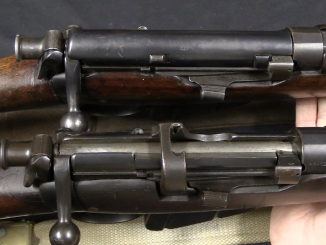This is lot #3294 in the upcoming RIA Premier Auction. It was scheduled for April, but has been postponed – check their web site for upcoming Online Only auctions every month, though!
Before modern revolvers, the pepperbox was a popular low-cost defensive firearm. Between the invention and patenting of proper revolvers and their widespread affordable availability, a transitional style of pepperbox grew up, particularly in the UK. These guns used a paperboy style action, with the barrel cluster truncated into a cylinder and a single rifled barrel affixed to the end of the axis pin. The result was a pretty weak firearm, but one which was accessible and inexpensive, and more accurate than the traditional smoothbore pepperbox.




Some firearm historians have blamed J N George in his book “English Pistols and Revolvers”, for popularising the term transitional revolvers for these pistols. They also maintain that they did not appear until Colt’s appearance at the Crystal Palace’s Great Exhibition of 1851. Everyone then wanted a revolving pistol abd the English gun trade attempted to meet this demand without infringing Colt’s English Patents. These patents had lasted for 14 years in the UK before expiring about 1851. However the English “proper” revolvers were primarily double action weapons with the cylinder revolved by the trigger actuated indexing hand locked by an extension on the trigger unlike Colt’s use of a hammer actuated cylinder revolvin hand and cylinder locking catch. Adams’ basic patent relied mainly on a one piece frame.
Gwyn
The major motivation for the makers of “transitional” revolvers was that having originally been makers of pepperbox type revolvers, they could get in on the market for new “single barrel” revolvers at minimal retooling costs.
They could also point to the fact that their weapons, which were intended primarily for self-defense against assailants at very close range and had the trigger-cocking type action originally patented by Ethan Allen in the United States, could be fired more rapidly than a Colt because they didn’t have to be thumb-cocked for each shot.
Incidentally, several makers introduced versions with lockwork that allowed both trigger-cocking and thumb-cocking, before Adams and Beaumont introduced that feature on their revolvers in 1858. So the transitional revolvers were among the first true “double-action” revolvers.
cheers
eon
Quite a few of the transitional revolver types, such as the Lang, had “gas-seal” cylinders which tracked forward to lock the mouth of the chamber over the breech end of the barrel, as on the later Nagant revolvers.
They didn’t really need a positive cylinder lock, as the gas-seal feature ensured that barrel and chamber were properly aligned when the hammer fired the chamber.
cheers
eon
This English Transitional Pepperbox Revolver reminded me (visually) SAVAGE-NORTH percussion revolver: https://guns.fandom.com/wiki/Savage_%26_North_Percussion_Revolver which also have cylinder moving forward-backward. Was there some inspiration?
The English and European gas-seal types came along well before the Savage-North. So I’d have to say the idea was originally from Europe, not the U.S.
cheers
eon
Where’s the Closed Captions?? 🙁
“defensive firearm” That depends solely on which side of the gun You are! I’m not at all a defender of every man/womans right to be able to buy any guns, as it costs many lives each year, in wain!
And how many lives are saved by folks being able to defend themselves from aggressors each year?
This gun is quite affordable, do not know the auction has taken place yet? Expecting the auction to be opened.